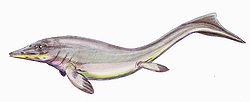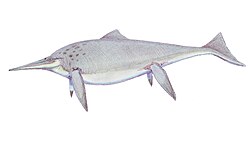| Kazakhstanosaurus Temporal range: Late Jurassic | |
|---|---|
| Scientific classification | |
| Kingdom: | Animalia |
| Phylum: | Chordata |
| Class: | Reptilia |
| Order: | † Ichthyosauria |
| Family: | † Ophthalmosauridae |
| Genus: | † Kazakhstanosaurus Bolatovna and Makustovich, 2021 |
| Type species | |
| †Kazakhstanosaurus efimovi Bolatovna and Makustovich, 2021 | |
| Species[ citation needed ] | |
| |
Kazakhstanosaurus (meaning "Kazakhstan lizard") is an extinct genus of undorosaurid ichthyosaur from the Late Jurassic of Kazakhstan and Russia. Two species are known: the type, K. efimovi, and K. shchuchkinensis, both named and described in 2021. [1]







